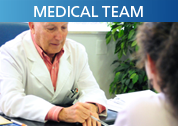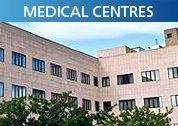Cardiology Treatment
Choosing where to have your heart surgery is important and while travelling abroad may not seem like the most obvious choice, it is worth considering. More and more people are choosing to have their treatment abroad, as they realise that excellent care is affordable and readily available. Mediterranean Health Care’s cardiology department is based at an award-winning hospital in Benidorm with state-of-the-art equipment and the latest technologies. Our doctors and surgeons have many years of experience in treating heart disease and are experts in cutting-edge treatments.
Why choose Mediterranean Health Care?
- Our doctors and surgeons have extensive experience and use the latest technology and procedures
- We have received awards for best hospital in our category in Spain
- We regularly treat patients from abroad, and our doctors speak many languages
- We have 24-hour service 365 days a year for patients who need it
- We are pioneers in renal denervation, a new treatment for high blood pressure that does not respond to other treatment
- Benidorm’s warm, sunny climate makes it an ideal place to rest and recuperate after your treatment
PROCEDURES
CLINICAL CARDIOLOGY AND HAEMODYNAMICS (CIRCULATION)
Cardiac catheterisation and coronary angioplasty
Cardiac catheterisation is a procedure used to detect obstructions or narrowing (stenosis) of the coronary arteries. The procedure involves inserting a catheter into your arteries. If coronary artery disease is diagnosed during catheterisation, one or several coronary angioplasties may be carried out.
Coronary angioplasty is a non-surgical treatment that expands a narrowed coronary artery and restores normal blood flow to your heart. It is used as an alternative to surgery (coronary bypass) or in addition to treatment with medication. The procedure works by inserting and then inflating a small balloon in the narrowed area.
During catheterisation, incisions will be made (probably in your groin and wrist) and a number of catheters (thin tubes) will be inserted, with the help of a special x-ray machine. A substance is injected through the catheter that will make your heart and major arteries and blood vessels show up on the x-ray.
If you have a coronary angioplasty as well, it will be done through the same incision. A special catheter (catheter guide) will be inserted as far as the place where the coronary disease begins. A very fine wire will then be inserted into the catheter and through the narrowed area. This guide will be used to carry another catheter with a small balloon at the tip. The balloon is then inflated, which expands the artery and restores normal blood flow to your heart. Sometimes there is a tube called a stent around the balloon, which will stay in your artery to keep it open after the balloon is deflated and the catheter removed. Most modern stents are coated with drugs that delay the development of any further narrowed areas.
You will be conscious or lightly sedated during your cardiac catheterisation or coronary angioplasty. The movement of the catheters through your arteries is not painful, so you will only need a local anaesthetic at the points where the catheters will be inserted. Catheterisation takes between 45 and 60 minutes.
ELECTROPHYSIOLOGY
Electrophysiological examination and intracardiac ablation
An electrophysiological examination is an invasive procedure used to study heart arrhythmia (irregular heartbeat). It is used when non-invasive tests (such as an echocardiogram or electrocardiogram) do not give the cardiologist enough information to be able to treat the arrhythmia.
The procedure pinpoints the exact location of electrical signals in the heart. This is known as ‘cardiac mapping’. The cardiologist will place several catheters directly in different parts of your heart. The catheters will transport the electrical signal they receive from your heart, and this is turned into information that your cardiologist can use to diagnose the type of arrhythmia you have, where it is coming from and how serious it is.
Cardiac ablation is an invasive procedure used to treat certain kinds of heart arrhythmia. It works by destroying the area causing the arrhythmia. The procedure involves using catheters to apply heat energy to destroy the problem area.
The movement of the catheters through your arteries is not painful, so you will only need a local anaesthetic at the points where the catheters will be inserted (probably your grain and your forearm). You will be lying face up during the procedure. It will probably take 1-5 hours, depending on whether you only have an electrophysiological study or whether ablation is also required, and how complex the ablation is.
Renal artery denervation treatment for refractory arterial hypertension
Refractory arterial hypertension (RAH) is a type of very high blood pressure that cannot be properly controlled by medication.
Renal denervation therapy is a very new and promising technique for treating this condition. In trials it has been shown to lowers blood pressure in 82% of patients and normalises it in 40%. This reduces the amount of medication these patients need to take and lowers the risk of complications caused by high blood pressure.
During the procedure a small catheter (tube) will be inserted through your femoral artery (in your abdomen or thigh) and then your renal artery, until it reaches the renal nerves. Once in place, radiofrequency is applied to suppress nerve activity, which should then lower your blood pressure.
The movement of the catheters through your arteries is not painful, so you will only need a local anaesthetic at the points where the catheters will be inserted. The whole procedure takes less than 80 minutes. You will normally be able to go home the next day.
HEART SURGERY
Aortic aneurysm repair
An aneurysm is a balloon-like bulge in an artery. Aortic aneurysms can occur in the chest area (thoracic aneurysm) or in the abdomen (abdominal aneurysm). An aneurysm develops when the force of blood pushing against a section of weakened artery pushes the walls, forming a type of blister that may rupture and cause a fatal haemorrhage. Repairing the aortic aneurysm stops the artery from rupturing.
The procedure involves replacing the weakened section of the artery with a synthetic tube (graft). In some cases, the aortic valve in your heart may need to be replaced.
Surgery is performed under general anaesthetic and takes 3-4 hours. If the aneurysm is in your descending thoracic aorta, an incision will be made in your chest. If the aneurysm is in your ascending aorta, the incision will be made near your breastbone. After the incision is made your heart will be stopped, and a heart-lung machine will be used to do the work normally done by your heart and lungs.
After the surgery, you will stay in the intensive care unit for 1-2 days, and then you will spend 5-7 days on the ward. If your job does not require physical effort, you will be able to go back to work after 4-6 weeks.
Coronary bypass surgery
A coronary bypass is an operation that restores blood flow to your heart when the coronary arteries are blocked by cholesterol plaque. It is the most common type of heart surgery.
The procedure creates a new route, or bypass, around the blocked or damaged section of your coronary artery. During surgery, a section of vein from your leg or chest artery (or from another part of your body) will be attached to the diseased coronary artery, bypassing the blocked section and creating a new route for blood flow.
You may have more than one bypass done at the same time. The number of bypasses is not necessarily indicative of the seriousness of the cardiovascular disease.
There are three possible types of surgery:
- Bypass with extracorporeal circulation (heart-lung machine): an incision is made along your breastbone (median sternotomy), your heart is stopped and your blood flows through a heart-lung machine (extracorporeal circulation).
- Bypass without extracorporeal circulation: an incision is made along your breastbone (median sternotomy), your heart continues beating and clamping systems are used on the coronary artery during surgery.
- Minimally invasive heart bypass surgery: this may involve a smaller incision, and it removes the need for a heart-lung machine and stopping your heart. It is recommended for select patients whose obstructions are easier to resolve and who have only a small risk of complications.
All three types of coronary bypass surgery are performed under general anaesthetic and take 3-4 hours. After surgery, you will stay in intensive care for 2 days and then spend 6-7 days on the ward. If your job does not require physical effort, you will be able to go back to work after 4-6 weeks.
Heart valve repair or replacement
The heart has four valves which open and close with each beat. They open to allow blood to flow through and then close securely to prevent the blood from flowing back.
A heart valve repair or replacement is used to treat valve disease, for example if the opening of the valve is narrowed (stenosis) or the valve does not close properly (regurgitation).
The procedure used to repair a valve depends on the condition that is being treated. Procedures include:
- commissurotomy: this is used when a valve has become narrowed because the flaps have become thicker or have fused
- valvuloplasty: a ring-type device is placed around the valve to make it firmer and allow it to close properly
- plastic repair: a section is cut from the valve and attached to the flap, allowing the valve to close correctly
- structural support repair: cords supporting the valve are replaced or shortened, enabling the valve to close correctly
- patching: a patch of tissue is used to cover a perforation or rupture in a valve
If the valve is too damaged to be repaired, it will be replaced. There are two types of replacement valves:
- mechanical valves, which are usually made of plastic, carbon and metal. They are tough and long lasting. Because blood tends to stick to this type of valve and form clots, you will have to take anticoagulants for the rest of your life.
- biological valves, which are made from animal or human tissue. No anticoagulant treatment is required, but they wear out more quickly than mechanical valves and may need changing after 15 years.
Valve repair or replacement surgery is performed under general anaesthetic and takes 3-4 hours. An incision will be made along your breastbone. Your heart will be stopped and your the blood is sent through a heart-lung machine. Your heart or aorta must be opened, which is why this type of operation is known as ‘open heart surgery’.
Patients generally spend around a week in hospital, of which 1-3 days will be in intensive care. If your job does not require physical effort, you will be able to go back to work after 4-6 weeks.
OUR CENTRE
Our cardiology and heart surgery department is located at the Hospital Clínica Benidorm, a modern private hospital in the province of Alicante, Spain. The area is a top tourist destination thanks to its sunshine, mild climate, clear seas, and nearby tourist attractions. The town is close to Alicante International Airport and is easily accessible by car or train.
The hospital has 166 beds, with 2 beds in each room. It also has 4 operating theatres and an intensive care unit with 14 beds.




